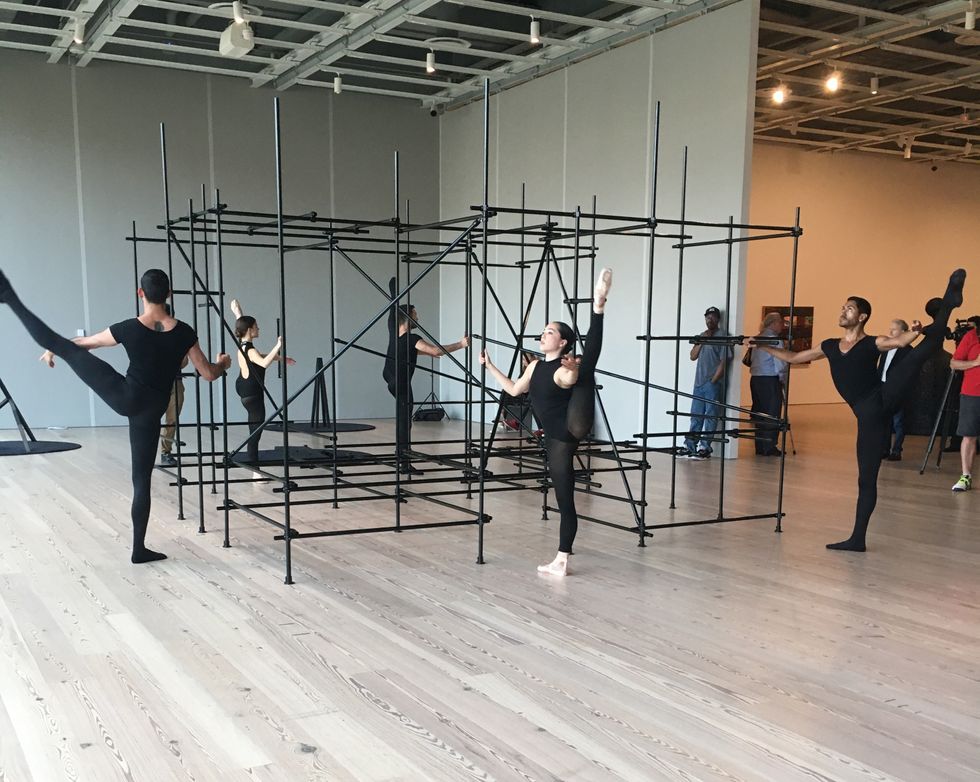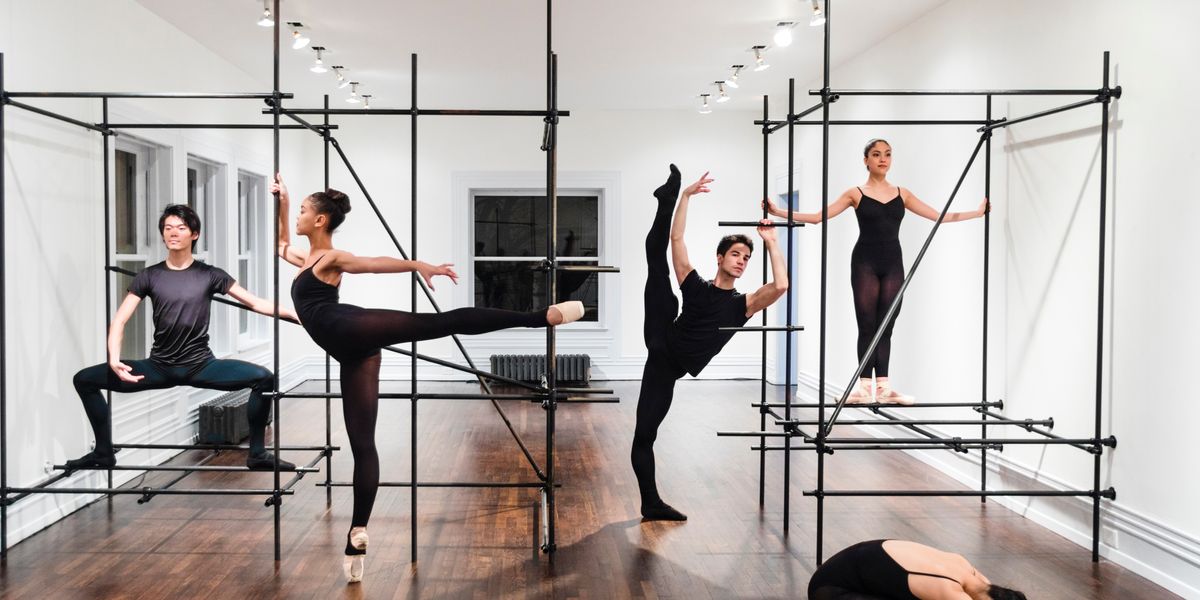This Whitney Biennial Exhibit Spotlights the Labor, Mastery and Discipline of Ballet Dancers
It sounds like a ballet dancer’s worst nightmare: hold extensions and splits for a prolonged period, improvise in a cage and on a rope, and execute a ballet barre to performance standards. Do it with no music, wearing just a leotard and tights for an audience that’s only two feet away, staring at every move.
Scary as that may sound, that’s what the dancers in “The Master And Form” are doing in nine shows a week through September 22 at the Whitney Museum of American Art in New York City. The exhibit, by Chicago-based artist Brendan Fernandes, is part of the Whitney Biennial 2019, which showcases the “latest developments” in American art.
“When dancers are performing, the feats look effortless,” says Fernandes. “But it’s labor, and dancers are masochists. I wanted to show the pain and the pleasure.”
Fernandes installed five sculptures along with a central cage and hanging ropes in the museum gallery, where a rotating cast of five dancers perform three one-hour shows, Friday through Sunday. When the dancers aren’t there, an audio recording of them plays, including their breath and the sound of their pointe shoes.
The dancers enter the gallery walking with pointed feet and turned out heels in a single line, snapping in time with their steps. They station themselves at one of the five structures, where they improvise and hold poses that interact with or mimic the sculpture, including full splits and a 180-degree penchée.
The show flow is in 10-minute cycles, including two at the sculptures, two improvising in and around the central cage structure, one performing a ballet barre and one improvising with hanging ropes. A timekeeper snaps to signal when 10 minutes are up, and the dancers move within the space to the next station with ballet walks and snaps, until they finally exit the same way.
 Dancers perform barre exercises during “The Master And Form” at the Whitney Biennial.
Dancers perform barre exercises during “The Master And Form” at the Whitney Biennial.
Avichai Scher
Fernandes gave the cast instructions on what their improv should include, but he also lets them make choices about what feels good for their bodies in the moment. “I give freedom and agency to the dancers, but it’s hard for them to take it,” Fernandes says. “I tell them to stop or take a break and they won’t.”
He made the work ethic and drive of ballet dancers part of the exhibit. By giving them the freedom not push themselves too hard, but knowing that they will, Fernandes shows ballet’s gritty side, which he sees as masochism. The exhibit’s notes pasted on the gallery wall liken it to S&M culture. “The space is like a BDSM playground,” says Fernandes. “There’s always questions of power and authority, dominance and subordination in ballet.”
Fernandes was born in Kenya and raised in Toronto, where he studied dance as a child and in college but did not dance professionally—he says it’s because he didn’t have the supple arches needed for ballet. But he has remained connected to dance through his art, including his 2014 work Standing Leg. In that piece, he performed with a foot stretcher to show the length of pain dancers will go to for perfection, and his own struggle with wanting better feet for ballet.
At a recent performance of “The Master And Form,” the dancers’ sweat and labor was in full view, but they appeared to have accepted Fernandes’ permission to take care of themselves. The cast at this performance featured two women: one, Allison Walsh, wore pointe shoes and the other, Violetta Komyshan, wore slippers. Since each cast performs three shows per day, the women usually take turns wearing pointe shoes. (“I love him for giving us the choice,” says Walsh.)
The dancers interspersed simple poses, such as the classic B-plus, with more strenuous ones. At times, they laid on their back with legs in the air and shook the cramps out of their feet.
Walsh, who danced with The Joffrey Ballet for seven years and on Broadway in An American in Paris and Anastasia, describes this performance experience as meditative. “When you’re in the corps holding poses, you want to move but you can’t,” she says. “Here, if you’re uncomfortable, you can step out. It’s freeing.”
One of the hardest aspects of the performance for Walsh is how close the audience is. They aren’t shy to walk up to the dancers and take pictures or film. “It’s kind of an invasion of privacy, they’re so close to us,” she says. “But you can tell people really appreciate the immersive experience we’re giving them.”
That was the case for Virginia Jeffries, a spectator visiting the museum. “When you go see dance, you can’t get close to the dancers like this,” she says. “It’s neat.”
 Dancer Allison Walsh stretches out on the floor as onlookers watch.
Dancer Allison Walsh stretches out on the floor as onlookers watch.
Avichai Scher.
When the dancers first entered the space, the exhibit room was filled with people waiting to see what they’d do. But as the hour-long performance went on, the crowd thinned to a few people. Without music or much movement, it’s hard to watch dancers push their bodies so hard. The work and sacrifice of ballet can’t be fully appreciated in just an hour, even if watching a performance of Swan Lake from the wings or observing the physical therapy room backstage. The only “outsiders” who really understand the struggle dancers go through are likely their family members, who watch students give nearly all their free time to classes and bring them an ice pack at the end of the day.
But “The Master And Form” works as way for the general public to understand the pain and beauty of achieving an “effortless” ballet performance. With the dancers used as an exhibit more than performers, it breaks the illusion of perfection that they work so hard to achieve.




